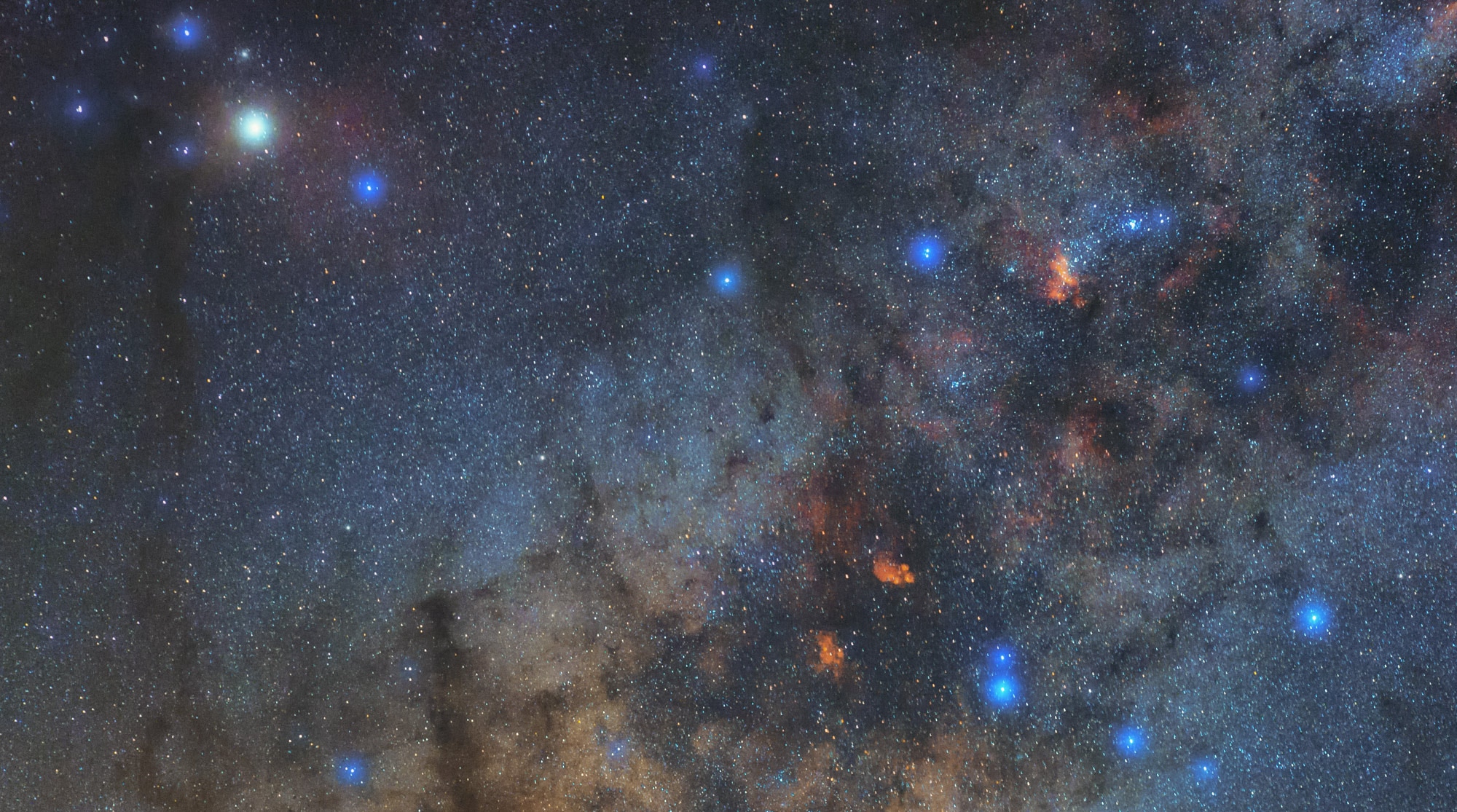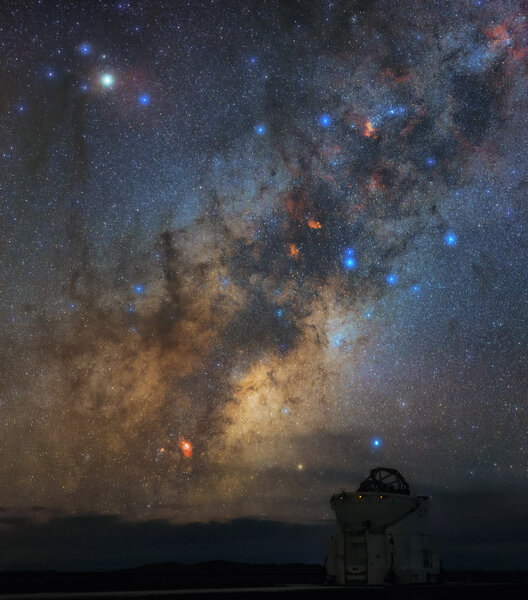Create a free profile to get unlimited access to exclusive videos, sweepstakes, and more!
A blue scorpion over South America

Every now and again I'll see a photo of the sky and have a "Wait, what?" moment. It doesn't happen hugely often, since after all these years of showing y'all the wonders of the Universe, I'm getting pretty familiar with what's what over our heads.
So when something like that does happen, it really throws me, and then I just have to share it.
Having said that, please let me share this dramatic and lovely photograph of the night sky:
This beautiful scene was taken by my friend Babak Tafreshi, a wonderful astrophotographer who travels the world to shoot gorgeous sky scenes. He also founded, directs, and is a contributor to The World At Night, a group of photographers dedicated to showing people the night sky, which is so quickly disappearing due to light pollution.
This shot was taken at the European Southern Observatory's Paranal site in Chile, South America. The telescope in the foreground is one of the four Auxiliary Telescopes that make up the Very Large Telescope Interferometer, an array of 'scopes that can have their feeds combined to mimic having a far larger 'scope. Each one of the ATs is a mere 1.8 meters in diameter. Mind you, the four individual ‘scopes that make up the VLT itself are 8.2 meters across! It's a monster facility.
As you can see, the Milky Way is sprawled against the sky, dotted with thousands of stars. The Milky Way is our home galaxy, a flat disk with a central bulge. We are inside that disk, so we see it as a fuzzy stream — a milky way, if you like — across the sky.
I've seen that many times. What threw me about this shot are actually two things in it. The first was exactly what stars we're seeing. I know that in Chile, the constellations appear upside-down to my Northern Hemisphere eyes. But even then I had a hard time identifying the constellation. Then I realized it's Scorpius, the scorpion, and the reason I couldn't ID it is that the three stars marking the head (or sometimes depicted as one of the claws) of the scorpion are not shown; they're off the frame to the upper left. Funny how without that cue I got totally lost.
But that's not all. Take another look at the image. Notice anything about the color? Almost all the bright stars are blue! That's not real, in the sense that not all those stars are actually blue. For example, the star about ¼ of the way down from the top in the middle is Epsilon Scorpii, a star that was once like the Sun but has used up the hydrogen in its core that it can use for fuel. This has caused the outer layers to expand and cool, turning it orange. Yet it looks blue in the photo.
The bright star to the upper left is the red supergiant Antares, one of the brightest stars in the sky, and easily seen to be red even by eye. But here it has a bluish-green cast to it. I know that can't be real because there are no green stars! So what gives?
I asked Babak, and he told me this is due to several factors. The 85mm lens he used suffers from a bit of chromatic aberration, which means red and blue light come to a slightly different focus. If you focus the lens for blue stars, red ones will appear slightly out of focus, and vice versa. So the blue glow around the stars is partly due to that. He also used a filter that knocks down some of the background skyglow, and that also preferentially makes the image look bluer. On top of that he used a subtle diffuser filter that also leverages blue light.
You'll notice the Milky Way, especially toward the bottom, and the stars near the horizon do look redder. I suspect that's mostly a natural effect due to haze and dust in the air. This scatters blue light away, letting redder light through (it's why the setting Sun can look orange or red).
On Instagram, Babak posted a different shot of the same stars (though a wider field of view) that was also taken in the Atacama Desert in Chile. In it, you can see a more natural color balance for the stars. Antares looks redder, and Epsilon Sco orange:
Once I understood all these details and got my bearings, it was fun to ID specific objects in the photo. The fuzzy red patch near the bottom, to the left of the telescope, is M8, the Lagoon Nebula, a gigantic gas cloud where stars are being born. That's a favorite target of amateur astronomers; it's bright and easy to find, and a delight to see even in small telescopes.
Near the center is another red patch called NGC 6357, another huge star factory. Seen using big telescopes, it's loaded with filaments and stars and incredibly hot gas, and is stunning. Check this out if you don't believe me.
Just above that and to the right is the Cat's Paw nebula. The name is because, with bigger ‘scopes, it really does look like the bottom of a cat's paw! The other red cloud a little farther up the Milky Way from there is IC 4628, sometimes called the Prawn Nebula. Guess why.
Funny, too: When I first described this image, I almost referred to it as a tableau (I like that word), but that implies "unmoving." However, if you grab the larger versions available you'll see the stars are very slightly streaked. There are a couple of reasons for that, too!
Partly it's due to the Earth's rotation reflected in the stars' motions; they were rising over the eastern horizon in this photo, and during the exposure moved a bit. In a photo using a normal lens you usually don't notice that until the exposure ranges into the 30-second time scale. However, it's noticeable in this 13-second exposure because it's an 85mm lens, a mild telephoto. That magnifies the motion.
Also, this is a three-panel mosaic. Babak had to move the pointing to get this entire scene between exposures, and that can mess with the tracking a bit (he also does something clever: He sets his tracking to move at half the speed the stars do in the sky. If he tracks the stars precisely the foreground objects on Earth will blur, so this splits the difference). Finally, the lens has a bit of what's called coma, where objects near the edges of the field of view can get distorted. This is inherent in many lenses and very difficult to counteract. One way is to only use the central part of the image, but then you have to take lots more subimages to make a mosaic. That would've been hard to produce this large chunk of the sky!
All in all, it's a great shot, and there's a lot to see and understand in it. Certainly the beauty of it is obvious, but underlying that is an important lesson in astronomy: What you see is not (and I would gently suggest "never") what you get. There are lots of ways information is distorted on its way from the subject to our brains, from the way we capture that data to the way it's processed and then even the way we interpret it.
Perhaps that's a lesson that isn't only limited to astronomy.
P.S. I originally saw this image on the ESO's Instagram feed. If you use it, following them there will be a delight for your eyes and brain.




























